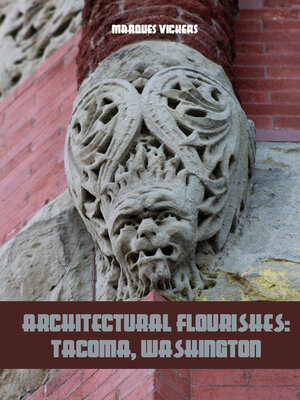
Sign up to save your library
With an OverDrive account, you can save your favorite libraries for at-a-glance information about availability. Find out more about OverDrive accounts.
Find this title in Libby, the library reading app by OverDrive.



Search for a digital library with this title
Title found at these libraries:
| Loading... |
"Architectural Flourishes: Tacoma, Washington" is a pictorial guide illustrates the features that capture the city's architecture legacy. The distinctive pre-Modernist examples of the late nineteenth through early twentieth century are liberally disbursed throughout the downtown, Old Town, Stadium, Ruston Point and Proctor districts. Over 230 photographs detail unique and distinctive exterior traits, statuary and notable design flourishes.
Tacoma was incorporated in 1875 following its selection two years earlier as the western terminus of the Northern Pacific Railroad. The railroad along with the city's deep-water port enabled significant commercial and industrial development leading up to the twentieth century.
Affluence and population migration followed with prime examples of the era's architecture mirroring the development. The most prominent styles include Greek Revival, Richardson Romanesque, Neo-Renaissance, Colonial Revival, Tudor Revival, Italian Renaissance Revival, Classical Revival and Beaux Arts.
The most distinctive building traits featured during this period were external design flourishes, decorative tile and molded masonry. This detailing often contrasts markedly with the almost sterile geometrical functionality of contemporary constructions. A viewer can easily recognize the artistry and craftsmanship behind these increasingly vanishing touches.
The Klondike Gold Rush of 1898 contributed towards Seattle eclipsing Tacoma in regional prominence. Seattle completely redesigned and rebuilt its downtown and commercial shipping industry following a devastating fire in 1889. For this reason, pre-Fire architecture is nonexistent within Seattle's Pioneer Square, but evident within Tacoma.
Tacoma was briefly considered a major destination for automobile racing and featured the third largest silent motion picture production studio in the world located at Titlow Beach in 1924.
During the mid to late twentieth century, Tacoma experienced a steady decline in perception and reputation. The Great Depression decimated local industry. In the 1930s, the infamous Aroma of Tacoma tainted breathing. The unsavory acrid odor was produced by local pulp and paper manufactures located in the local tide flats. In November 1940, the Tacoma Narrows Bridge connecting the city with Kitsap County dramatically collapsed into Puget Sound following only four months of operation.
As misfortune piled upon calamity, Tacoma's downtown became abandoned and virtually uninhabitable. Crime rates rose significantly and organized gang activity solidified its presence.
The city's reputation skidded to the bottom in the late 1980s, yet the decline proved reversible. During the 1990s, a sustained and resilient renovation program began with the recruitment of a University of Washington campus, world-class art museum construction and extensive downtown redevelopment. Rather than constructing characterless glass rectangular structures, the focus became the rejuvenation of existing buildings.
The interiors were often gutted and reconfigured. Most importantly, the exteriors were freshened and revitalized. This collective coordinated effect by the preservationists opened the downtown into a unique and distinctive portal to the past while still servicing contemporary needs.
The results have become a re-appreciation towards the aesthetic value of architecture in elevating lifestyle. This edition's images bear testament to this critical detailing component.






